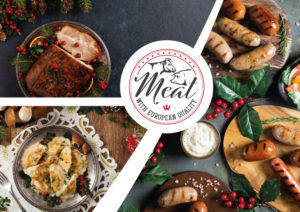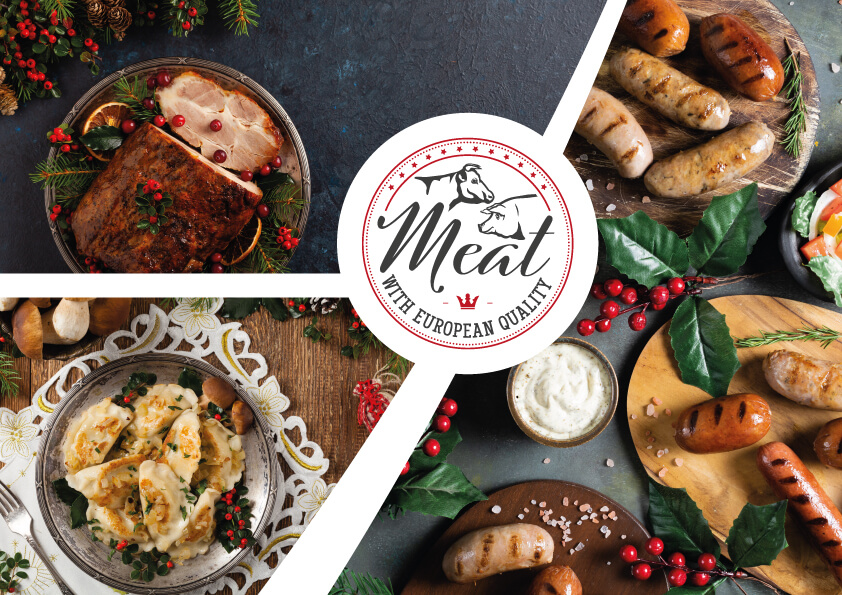The European Union is the place of birth of many cultural inspirations, which were later spread across the globe. One inspiration is the tradition of celebrating Christmas. Although everyone knows traditions of giving presents to each other, Santa Claus, having meals with family, in many places of the world it is the joint celebration of Christmas with those closest to us that is the focal point of our Christmas experience. But no holiday is complete without a lavishly set table – the culinary and geographically diverse European Union has plenty of delicious and interesting options that could easily appear on the American table this Christmas.
Christmas is one of the most important holidays in the USA – up to 96% of Americans celebrate it[1]. That is why it is important to consider what dishes are prepared for this important event for American families. Potatoes, along with roasts and meat products, are the most popular holiday dishes. The most popular dishes were ribs (69%), steak (65%), ham or roast (62%) and beef brisket (56%)[2]. Most of these dishes come from Anglo-Saxon traditions, so Christmas can involve very similar dishes in Ireland, for example. However, it is also worth looking at recipes that are popular in other EU countries.
Pork is especially popular for the holidays in Europe east of Germany. Some of the most popular dishes include roasts and sausages. Sausages for the holidays are especially often served in eastern European countries. Fried or baked sausage – Bratwurst, served with sauerkraut, is a holiday delicacy in Austria. And in Estonia, black pudding is popular, also served with sauerkraut. White sausage and smoked ham are popular in Romania, served with garlic, onions and freshly baked bread – colacii[3]. Sausage can also be served with cabbage in one dish, as it is the case for bigos, a holiday dish from Poland. Bigos contains a lot of ingredients – cabbage, sliced and fried sausage, pieces of stewed meat, and a variety of vegetables or mushrooms. This dish can be served with boiled and squashed peas[4]. Dumplings, a larger version of ravioli, often fried after cooking, are also popular in Central and Eastern Europe. Pierogi are stuffed with cabbage, mushrooms, meat or lentils. The further north you go, the more popular glazed roasts are. In every country around the Baltic Sea, baked ham or bacon is an indispensable part of the holiday table. One of the most popular pork dishes is glazed ham, which is first properly marinated in mustard, honey and sugar. Such marinade and prolonged roasting ensure not only high juiciness and great taste, but also the characteristic dark brown colour. This type of ham can also be roasted with thyme, onions or apples in the west and north of Europe or served with pickles, potato salad or horseradish in Eastern Europe. Culinary applications and forms are limited only by the cook’s culinary creativity.
Beef is another red meat that is especially popular throughout the winter holidays. Among all the countries of the Union, beef is most frequently consumed during the holidays on the green island of Ireland. It is prepared in various ways – marinated and stewed in the form of a stew or baked as the so-called “standing roast” – refined cuts of beef on the bone in the oven and roasted for a long time. It is to this method of baking that the dish owes its name. These dishes are usually accompanied by meat-based sauces and mashed potatoes[5], quite similar to American tables.
Although in some countries people do not eat meat on Christmas Eve, the preparation of meat dishes for the holidays has a long tradition[6]. Throughout the centuries, due to environmental conditions, the winter solstice was when animals were slaughtered – the possibility of further grazing was limited, and storing large quantities of fodder in winter was a lot more difficult than today. This phenomenon has survived intact to this day in the Balkans, where before Christmas, local communities prepare fresh pork and other meat products in this way. In Slovenia, this tradition is called “koline”, whereas in Romania it is called “Tāierea porcului”. Of course, these processes are carried out with consideration to European animal welfare regulations and cross-compliance requirements.
The European Union has a lot to offer not only in terms of holiday recipes, but also in terms of products to put on your holiday table. Choosing products from Europe is a great way to have a tasty and aromatic Christmas with your loved ones.

- [1] https://www.washingtontimes.com/blog/watercooler/2013/dec/23/what-christmas-wars-90-percent-all-americans-celeb/
- [2] https://www.tasteofhome.com/article/the-most-popular-christmas-dish-across-america/
- [3] https://europeisnotdead.com/european-christmas-dinners/
- [4] https://beszamel.se.pl/przepisy/dania-glowne-bezmiesne/kapusta-z-grochem-na-wigilie-przepis-re-7rDX-7zXa-hctN.html
- [5] https://vagabondtoursofireland.com/guinness-for-santa-claus-irish-christmas-food-traditions
- [6] https://www.romania-insider.com/four-romanians-face-jail-italy-pig-slaughter
